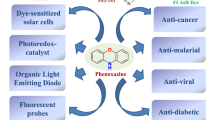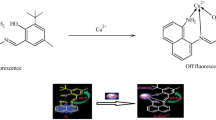Abstract
Reduction of aromatic azides to amines is an important property of hydrogen sulphide (H2S) which is useful in fluorescence microscopy and H2S probing in cells. The aim of this work is to study the substituent effect on the absorption and emission spectra of 2-(2′-aminophenyl)benzothiazole (APBT) in order to design APBT derivatives for the use of H2S detection. Absorption and emission spectra of APBT derivatives in aqueous environment were calculated using density functional theory (DFT) and time-dependent DFT (TD-DFT) at B3LYP/6-311+G(d,p) level. The computed results favoured the substitution of strong electron-donating group on the phenyl ring opposite to the amino group for their large Stokes’ shifts and emission wavelengths of over 600 nm. Also, three designed compounds were suggested as potential candidates for the fluorescent probes. Such generalised guideline learnt from this work can also be useful in further designs of other fluorescent probes of H2S in water.





Similar content being viewed by others
References
Wang R et al (2012) Sensitive near-infrared fluorescent probes for thiols based on Se-N bond cleavage: imaging in living cells and tissues. Chem Eur J 18(36):11343–11349
Yu F, Han X, Chen L (2014) Fluorescent probes for hydrogen sulfide detection and bioimaging. Chem Commun 50(82):12234–12249
Kamoun P (2004) Endogenous production of hydrogen sulfide in mammals. Amino Acids 26(3):243–254
Abe K, Kimura H (1996) The possible role of hydrogen sulfide as an endogenous neuromodulator. J Neurosci 16(3):1066–1071
Hosoki R, Matsuki N, Kimura H (1997) The possible role of hydrogen sulfide as an endogenous smooth muscle relaxant in synergy with nitric oxide. Biochem Biophys Res Commun 237(3):527–531
Madden JA et al (2012) Precursors and inhibitors of hydrogen sulfide synthesis affect acute hypoxic pulmonary vasoconstriction in the intact lung. J Appl Physiol 112(3):411–418
Tripatara P et al (2009) Characterisation of cystathionine gamma-lyase/hydrogen sulphide pathway in ischaemia/reperfusion injury of the mouse kidney: an in vivo study. Eur J Pharmacol 606(1–3):205–209
Wang P et al (2011) Hydrogen sulfide and asthma. Exp Physiol 96(9):847–852
Paul BD, Snyder SH (2012) H2S signalling through protein sulfhydration and beyond. Nat Rev Mol Cell Biol 13(8):499–507
Lin VS, Chang CJ (2012) Fluorescent probes for sensing and imaging biological hydrogen sulfide. Curr Opin Chem Biol 16(5–6):595–601
Sivakumar K et al (2004) A fluorogenic 1,3-dipolar cycloaddition reaction of 3-azidocoumarins and acetylenes. Org Lett 6(24):4603–4606
Zhou Z, Fahrni CJ (2004) A fluorogenic probe for the copper(I)-catalyzed azide − alkyne ligation reaction: modulation of the fluorescence emission via 3(n, π*) − (π, π*) inversion. J Am Chem Soc 126(29):8862–8863
Xie F et al (2008) A fluorogenic ‘click’ reaction of azidoanthracene derivatives. Tetrahedron 64(13):2906–2914
Das SK et al (2012) A small molecule two-photon probe for hydrogen sulfide in live tissues. Chem Commun 48(67):8395–8397
Bailey TS, Pluth MD (2013) Chemiluminescent detection of enzymatically produced hydrogen sulfide: substrate hydrogen bonding influences selectivity for H2S over biological thiols. J Am Chem Soc 135(44):16697–16704
Wang C et al (2011) Tuning the optical properties of BODIPY dye through Cu(I) catalyzed azide-alkyne cycloaddition (CuAAC) reaction. Sci China Chem 55(1):125–130
Huo F-J et al (2015) Highly selective fluorescent and colorimetric probe for live-cell monitoring of sulphide based on bioorthogonal reaction. Sci Rep 5:8969
Jiajin Z et al (2006) Two-photon-induced excited state intramolecular proton transfer process and nonlinear optical properties of HBT in cyclohexane solution. J Opt A Pure Appl Opt 8(10):835
Rodembusch FS et al (2005) The first silica aerogels fluorescent by excited state intramolecular proton transfer mechanism (ESIPT). J Mater Chem 15(15):1537–1541
Wang R et al (2009) Substituent and solvent effects on excited state intramolecular proton transfer in novel 2-(2′-hydroxyphenyl)benzothiazole derivatives. J Photochem Photobiol A Chem 205(1):61–69
Arthen-Engeland T et al (1992) Singlet excited-state intramolecular proton tranfer in 2-(2 t’-hydroxyphenyl) benzoxazole: spectroscopy at low temperatures, femtosecond transient absorption, and MNDO calculations. Chem Phys 163(1):43–53
Das K et al (1994) Excited-state intramolecular proton transfer in 2-(2-hydroxyphenyl)benzimidazole and -benzoxazole: effect of rotamerism and hydrogen bonding. J Phys Chem 98(37):9126–9132
Daengngern R, Kungwan N (2015) Electronic and photophysical properties of 2-(2′-hydroxyphenyl)benzoxazole and its derivatives enhancing in the excited-state intramolecular proton transfer processes: a TD-DFT study on substitution effect. J Lumin 167:132–139
Dogra SK (2005) Spectral characteristics of 2-(3′,5′-diaminophenyl)benzothiazole: effects of solvents and acid–base concentrations. J Photochem Photobiol A Chem 172(2):185–195
Dey JK, Dogra SK (1991) Solvatochromism and Prototropism in 2-(Aminophenyl)benzothiazoles. Bull Chem Soc Jpn 64(10):3142–3152
Jiang Y, Wu Q, Chang X (2014) A ratiometric fluorescent probe for hydrogen sulfide imaging in living cells. Talanta 121:122–126
Zhang J, Guo W (2014) A new fluorescent probe for gasotransmitter H2S: high sensitivity, excellent selectivity, and a significant fluorescence off-on response. Chem Commun 50(32):4214–4217
Becke AD (1993) A new mixing of Hartree–Fock and local density‐functional theories. J Chem Phys 98(2):1372–1377
Lee C, Yang W, Parr RG (1988) Development of the Colle-Salvetti correlation-energy formula into a functional of the electron density. Phys Rev B 37(2):785–789
Miehlich B et al (1989) Results obtained with the correlation energy density functionals of becke and Lee Yang and Parr. Chem Phys Lett 157(3):200–206
Matsuzawa NN et al (2001) Time-dependent density functional theory calculations of photoabsorption spectra in the vacuum ultraviolet region. J Phys Chem A 105(20):4953–4962
Jacquemin D et al (2006) Time-dependent density functional theory investigation of the absorption, fluorescence, and phosphorescence spectra of solvated coumarins. J Chem Phys 125(16):164324
Chibani S et al (2012) On the computation of adiabatic energies in Aza-Boron-dipyrromethene dyes. J Chem Theory Comput 8(9):3303–3313
Houari Y, Jacquemin D, Laurent AD (2013) TD-DFT study of the for coumarins. Chem Phys Lett 583:218–221
Zakrzewska A et al (2013) Substituent effects on the photophysical properties of fluorescent 2-benzoylmethylenequinoline difluoroboranes: a combined experimental and quantum chemical study. Dyes Pigments 99(3):957–965
Laurent AD, Adamo C, Jacquemin D (2014) Dye chemistry with time-dependent density functional theory. Phys Chem Chem Phys 16(28):14334–14356
Tseng H-W et al (2015) Harnessing excited-state intramolecular proton-transfer reaction via a series of amino-type hydrogen-bonding molecules. J Phys Chem Lett 6(8):1477–1486
Chen C-L et al (2016) Insight into the amino-type excited-state intramolecular proton transfer cycle using N-tosyl derivatives of 2-(2′-Aminophenyl)benzothiazole. J Phys Chem A 120(7):1020–1028
Becke AD (1993) Density‐functional thermochemistry. III. The role of exact exchange. J Chem Phys 98(7):5648–5652
Stephens PJ et al (1994) Ab initio calculation of vibrational absorption and circular dichroism spectra using density functional force fields. J Phys Chem 98(45):11623–11627
Adamo C, Barone V (1999) Toward reliable density functional methods without adjustable parameters: the PBE0 model. J Chem Phys 110(13):6158–6170
Zhao YT, Truhlar DG (2006) Density functional for spectroscopy: No long-range self-interaction error, good performance for Rydberg and charge-transfer states, and better performance on average than B3LYP for ground states. J Phys Chem A 110:13126–13130
O’boyle NM, Tenderholt AL, Langner KM (2007) cclib: a library, f.p.-i.c.c. algorithms. J Comput Chem 29(5):839–845
Frisch MJ et al (2010) Gaussian 09 revisions C.01 & B.01. Gaussian, Inc., Wallingford
Acknowledgements
This research is financially sponsored by the Research Administration Office, Graduate School of Chiang Mai University and Thailand Research Fund (MRG5980189 and RSA5880057) for the financial support.
Author information
Authors and Affiliations
Corresponding author
Rights and permissions
About this article
Cite this article
Manojai, N., Daengngern, R., Kerdpol, K. et al. TD-DFT Study of Absorption and Emission Spectra of 2-(2′-Aminophenyl)benzothiazole Derivatives in Water. J Fluoresc 27, 745–754 (2017). https://doi.org/10.1007/s10895-016-2007-9
Received:
Accepted:
Published:
Issue Date:
DOI: https://doi.org/10.1007/s10895-016-2007-9




